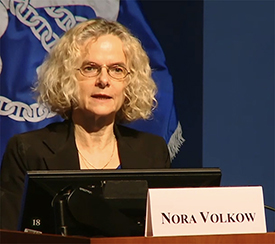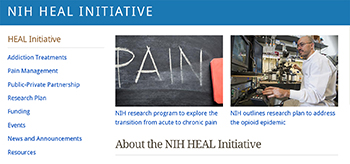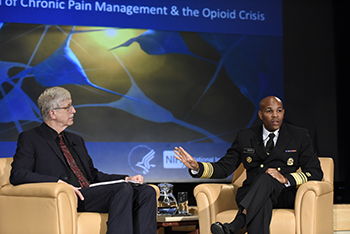Opioid Addiction and Chronic Pain
NIH Pain Consortium Symposium Highlights
The United States is facing a double crisis: opioid addiction and unrelieved pain. An estimated two million Americans are addicted to opioids; overdose fatality rates rose more than 20 percent in the past two years. Some 25 million Americans suffer from daily chronic pain and lack effective non-opioid treatments to manage that pain.
As part of the effort to address these growing problems, researchers and health-care providers met at the 13th annual NIH Pain Consortium Symposium (held on NIH’s Bethesda, Maryland, campus, May 31 and June 1, 2018) to learn about recent advances in pain research, clarify priorities, and discuss opportunities to improve the treatment of pain. The symposium, From Science to Society—At the Intersection of Chronic Pain Management and the Opioid Crisis, included presentations, posters, and a fireside chat between NIH Director Francis Collins and U.S. Surgeon General Jerome Adams.

NIDA Director Nora Volkow, who gave opening remarks at the symposium, emphasized that basic and clinical researchers need to coordinate their efforts in order to address the opioid crisis and the high rates of patients suffering from chronic pain.
Nora Volkow, director of the National Institute on Drug Abuse (NIDA), opened the symposium by outlining the problems Americans face and the roadmap the NIH has devised to fight this public-health threat. She emphasized that although the overprescription of opioids—which led to misuse of these drugs—may have triggered the opioid crisis, currently the greatest number of overdose deaths are from heroin and fentanyl, black-market alternatives for prescription opioids. The high rates of patients suffering from chronic pain combined with the potency and addictiveness of opioids mean there must be a coordinated effort between basic and clinical researchers to address the crisis. Researchers are tasked with finding nonaddictive pain relievers, characterizing the transition from acute to chronic pain, and developing biomarkers for pain.
Volkow described the April 2018 launch of the NIH Helping End Addiction Long-term (HEAL) Initiative, an aggressive trans-agency effort to speed scientific solutions to stem the opioid public-health crisis. Thanks to a Congressional appropriation of $500 million in fiscal year 2018, NIH nearly doubled its funding for opioid-related and pain research from almost $600 million to $1.1 billion. The HEAL initiative will support research to provide new strategies for the prevention and treatment of opioid misuse and addiction; understand the biological underpinnings of chronic pain; develop new drugs to treat pain; and find evidence-based ways to integrate nonpharmaceutical pain-management techniques. NIH will also work with partners from the biopharmaceutical industry to develop a data-sharing collaborative; find new biomarkers for pain; and develop a clinical-trials network to test new pain therapies.

The trans-NIH Helping End Addiction Long-term (HEAL) Initiative aims to support research that will provide new strategies for the prevention and treatment of opioid misuse and addiction; understand the biological underpinnings of chronic pain; develop new drugs to treat pain; and find evidence-based ways to integrate nonpharmaceutical pain-management techniques.
The symposium’s keynote address featured Judith Paice (a research professor of medicine and director of the Cancer Pain Program at Northwestern University, Evanston, Illinois), who highlighted the unintended consequences of restricting prescription opioids for people suffering from chronic pain. Limits on these prescriptions may cause patients to undermedicate; health-care providers to deny opioid-prescription authorizations for fear of being held responsible for opioid misuse; [and] physicians [to be] limited in their ability to treat chronic pain including for “people with cancer [who] can live for a very long time [with] pain,” said Paice. “We need to improve access.” Paice pointed out that finding effective ways to control pain and deal with the opioid epidemic must consider the roles of economic despair, mental illness, and social isolation in the spread of the opioid epidemic. She also stressed the importance of integrating evidence-based guidelines with treatment plans for dealing with both chronic pain and substance-use disorders.
Symposium highlights
Other presentations at the symposium focused on pain management from a variety of perspectives including interactions between pain and reward circuitry in opioid action, demographic disparities in pain management, a patient’s perspective on the intersection of chronic pain and opioid restrictions, and non-opioid neurotechnologies developed under the NIH Brain Research through Advancing Innovative Neurotechnologies (BRAIN) Initiative. Following are highlights from talks by an intramural investigator and two NIH alums.
Michaela Prochazkova, a postdoc in Ashok Kulkarni’s lab (National Institute of Dental and Craniofacial Research, NIDCR), is exploring ways to relieve orofacial pain by blocking cyclin-dependent kinase 5 (Cdk5) activity in mouse models. Cdk5 plays an important role in pain signaling, but commercially available Cdk5 inhibitors lack specificity and might cause unwanted side effects. Prochazkova described how she and other lab members collaborated with Harish Pant (National Institute of Neurological Disorders and Stroke, NINDS) and found that the neuroprotective agent TFP5, a peptide inhibitor of aberrant and hyperactive Cdk5, was effective in relieving orofacial pain. (TFP5, developed by Pant’s lab, is typically used to provide neuroprotective effects in animal models of neurodegenerative disorders.)
NIH alum Jose Moron-Concepcion, an associate professor of anesthesiology and neuroscience at Washington University (St. Louis, Missouri), is determined to understand the mechanisms underlying opioid addiction and pain. From 1999 to 2001, he was a postdoc in the lab of the late Toni Shippenberg (NIDA), a pioneer in the field of opioid pharmacology. In his symposium presentation, “Opioid-induced Plasticity and the Intersection with Pain,” Moron-Concepcion described his research showing how the relationship between pain and motivation plays a role in governing opioid self-administration in rodents. He also talked about monitoring neural activity in mice as they navigated virtual reality environments that link cues with the presence or absence of opioids. Initial results show increased firing in the hippocampal region CA1 when the mice enter an environment with stripe patterns previously associated with the drug, suggesting that these memory-associated circuits might play a role in the creation of cues that trigger drug-seeking and relapse.
NIH has shaped the careers of other pain experts who appeared at the symposium including the president of the American Pain Society (APS), William Maixner, who gave an update of the organization’s priorities and activities. Maixner was a research fellow in NIDCR in the 1980s and is now a professor of anesthesiology and co-director of the Center for Translational Pain Medicine at Duke University (Durham, North Carolina). He considers chronic pain to be a “hidden epidemic” and voiced his appreciation for how the NIH HEAL Initiative provides new opportunities for APS to partner with the U.S. Department of Health and Human Services to reverse the opioid epidemic. The APS concentrates on research, education, patient management, and advocacy. One of its priorities is to disseminate new knowledge generated by pain research, primarily through publishing the Journal of Pain and by hosting the APS annual meeting.
Fireside Chat with the U.S. Surgeon General. The symposium also featured a conversation between U.S. Surgeon General Jerome Adams and NIH Director Francis Collins. They discussed the opioid epidemic, chronic pain, and how disparities in access to health care exacerbate these problems. Adams stressed the need for reducing the stigma surrounding mental-health illnesses and addiction. He is pushing for naloxone, a medication that rapidly reverses opioid overdose, to be sold over-the-counter in pharmacies. He urged everyone to carry naloxone to help fight the opioid epidemic right now.

PHOTO BY ANDREW PROPP, OD
NIH Director Francis Collins (left) and U.S. Surgeon General Jerome Adams discuss the opioid crisis and chronic pain at the NIH Pain Consortium Symposium held on May 31 and June 1, 2018.
“We can’t save someone if they’re not alive,” said Adams. “We need naloxone to be as ubiquitous as CPR or defibrillators.”
Adams also hopes to tackle disparities in health-care access, particularly in rural America. “Any problem in urban areas is 10 times worse in rural areas because of stigma and [lack of] access” to health-care services, he said. He wants to use his position to push education and care to areas that need it most, especially rural communities.
The surgeon general encouraged the audience to seize the opportunities that media coverage of the opioid crisis brings to the field of pain research. He warned against an overly mechanistic view of pain with too narrow a focus on new drug treatments. Instead, he encouraged a view that accounts for the biological, emotional, and spiritual components of pain and offers a broad range of interventions. To ensure that these interventions become widely available, value-based payment models would be beneficial.
“We need the most rigorous visionary basic science to teach us critical things we don’t know about mechanisms and molecules and learn about a condition to be able to intervene effectively,” said Adams. The challenge is “how do you rapidly translate what have you learned in that basic-science arena into something that’s going to help somebody?”
The NIH Pain Consortium was established in 1996 and revitalized in 2003 to enhance pain research and promote collaboration among researchers across the many NIH institutes and centers that have programs and activities addressing pain. For links to the meetings summary and webcasts for the NIH Pain Consortium Symposium (held on May 31 and June 1, 2018), click here.
This page was last updated on Wednesday, April 6, 2022
